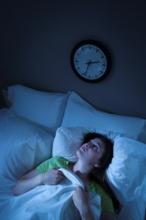PHOENIX – Reducing bedtime stimulation and, oddly enough, restricting sleep both have powerful, relatively fast effects on insomnia, especially when used in tandem.
Among cognitive-behavioral therapy approaches, they have the best supporting evidence and, "happily, are the easiest to do," said Allison Harvey, Ph.D., director of the University of California, Berkeley, Golden Bear Sleep and Mood Research Clinic.
The goal is to teach insomniacs that their beds are for sleeping, not watching TV, surfing the Net, eating potato chips, or fretting about not getting enough sleep.
Sleep restriction limits their time in bed to the time they actually sleep. The first step is to discover that ratio by having patients keep a sleep diary for a week or 2. Insomniacs are usually about 60% sleep efficient; for every 8 hours in bed, they’ll sleep about 5.
The next step is limiting bed time to sleep time. At first, that might cause a bit of sleep deprivation, but that’s a good thing because it builds homeostatic pressure to sleep, Dr. Harvey said.
The goal is 85% sleep efficiency; 4.25 hours of sleep, for instance, for every 5 hours in bed. As long as patients remain 85% efficient, time in bed can be increased by 15 minutes every 5 or so days. Within about 6 weeks, patients should be getting an efficient 7 or 8 hours of sleep per night.
At first, "we never go less than 5 hours a night" and "make the determination of how low we go dependent on safety issues. So, if someone’s a truck driver, we probably wouldn’t do this treatment. If someone has bipolar disorder, I wouldn’t go below 6½ hours because sleep deprivation can trigger a manic episode." Naps are okay if needed, so long as they are before 3 p.m. and are 30 minutes or less, Dr. Harvey said.
Stimulus control reinforces the bed-sleep connection. If patients aren’t asleep within 20 minutes, "Don’t let them clock watch. [Tell them to] get up and move to another room, and stay up until they are really sleepy," she said.
If they want to read, it shouldn’t be something that will keep them up all night. If they want to watch TV, it should be something relaxing, not channel surfing. If they’re anxious, writing in a journal can help.
"I had one patient who said, ‘Oh, I can get some housework done.’ No. Nothing productive. Other patients say, ‘I can get on my computer and do some e-mail.’ No; [they need] dim light conditions," Dr. Harvey said.
Flexibility is important. Some patients might want to restrict sleep in the evening, others in the morning. Both are fine. Some patients might worry that 5 hours is too little bedtime, so "start with 7½; it’s better than 8½. Sleep efficiency will pop up a bit, they’ll get confidence. They’ll come down to seven hours the next week. Just base it on what makes sense for the person," Dr. Harvey said.
It might take a few weeks for patients to see benefits, so support is important, too. Troubleshoot their routine for problems, and encourage them to continue the program, she said.
It’s uncertain what benefit sedative hypnotics such as zolpidem (Ambien) would add to the approach, she noted.
Dr. Harvey reported having no relevant financial disclosures.

